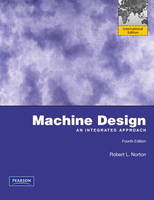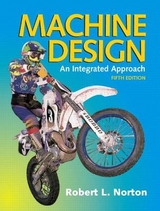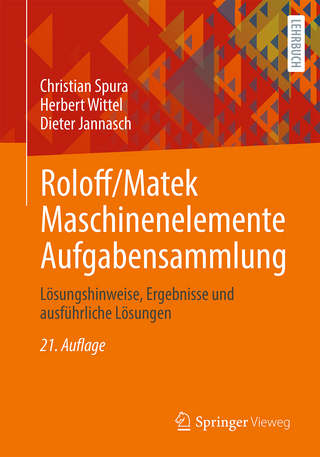
Machine Design
Pearson (Verlag)
978-0-13-138438-5 (ISBN)
- Titel erscheint in neuer Auflage
- Artikel merken
Machine Design, 4/e, presents the subject matter in an up-to-date and thorough manner with a strong design emphasis. This textbook emphasizes both failure theory and analysis as well as emphasizing the synthesis and design aspects of machine elements. The book points out the commonality of the analytical approaches needed to design a wide variety of elements and emphasizes the use of computer-aided engineering as an approach to the design and analysis of these classes of problems.
Robert L. Norton earned undergraduate degrees in both mechanical engineering and industrial technology at Northeastern University and an MS in engineering design at Tufts University. He is a registered professional engineer in Massachusetts. He has extensive industrial experience in engineering design and manufacturing and many years’ experience teaching mechanical engineering, engineering design, computer science, and related subjects at Northeastern University, Tufts University, and Worcester Polytechnic Institute. At Polaroid Corporation for 10 years, he designed cameras, related mechanisms, and high-speed automated machinery. He spent three years at Jet Spray Cooler Inc., designing food-handling machinery and products. For five years he helped develop artificial-heart and noninvasive assisted-circulation (counterpulsation) devices at the Tufts New England Medical Center and Boston City Hospital. Since leaving industry to join academia, he has continued as an independent consultant on engineering projects ranging from disposable medical products to high-speed production machinery. He holds 13 U.S. patents. Norton has been on the faculty of Worcester Polytechnic Institute since 1981 and is currently the Milton P. Higgins II Distinguished Professor of Mechanical Engineering, Russell P. Searle Distinguished Instructor, Head of the Design Group in that department, and the Director of the Gillette Project Center at WPI. He teaches undergraduate and graduate courses in mechanical engineering with emphasis on design, kinematics, vibrations, and dynamics of machinery. He is the author of numerous technical papers and journal articles covering kinematics, dynamics of machinery, cam design and manufacturing, computers in education, and engineering education and of the texts Design of Machinery, Machine Design: An Integrated Approach and the Cam Design and Manufacturing Handbook. He is a Fellow of the American Society of Mechanical Engineers and a member of the Society of Automotive Engineers. But, since his main interest is in teaching, he is most proud of the fact that, in 2007, he was chosen as U. S. Professor of the Year for the State of Massachusetts by the Council for the Advancement and Support of Education (CASE) and the Carnegie Foundation for the Advancement of Teaching, who jointly present the only national awards for teaching excellence given in the United States of America.
PART I FUNDAMENTALS 1
CHAPTER 1 INTRODUCTION TO DESIGN
1.1 Design
Machine Design
Introduction to Design
Machine
Iteration
1.2 A Design Process
1.3 Problem Formulation and Calculation
Definition Stage
Preliminary Design Stage
Detailed Design Stage
Documentation Stage
1.4 The Engineering Model
Estimation and First-Order Analysis
The Engineering Sketch
1.5 Computer-Aided Design and Engineering
Computer-Aided Design (CAD)
Computer-Aided Engineering (CAE)
Computational Accuracy
1.6 The Engineering Report
1.7 Factors of Safety and Design Codes
Factor of Safety
Choosing a Safety Factor
Design and Safety Codes
1.8 Statistical Considerations
1.9 Units
1.10 Summary
1.11 References
1.12 Web References
1.13 Bibliography
1.14 Problems
CHAPTER 2 MATERIALS AND PROCESSES
2.0 Introduction
2.1 Material-Property Definitions
The Tensile Test
Ductility and Brittleness
The Compression Test
The Bending Test
The Torsion Test
Fatigue Strength and Endurance Limit
Impact Resistance
Fracture Toughness
Creep and Temperature Effects
2.2 The Statistical Nature of Material Properties
2.3 Homogeneity and Isotropy
2.4 Hardness
Heat Treatment
Surface (Case) Hardening
Heat Treating Nonferrous Materials
Mechanical Forming and Hardening
2.5 Coatings and Surface Treatments
Galvanic Action
Electroplating
Electroless Plating
Anodizing
Plasma-Sprayed Coatings
Chemical Coatings
2.6 General Properties of Metals
Cast Iron
Cast Steels
Wrought Steels
Steel Numbering Systems
Aluminum
Titanium
Magnesium
Copper Alloys
2.7 General Properties of Nonmetals
Polymers
Ceramics
Composites
2.8 Selecting Materials
2.9 Summary
2.10 References
2.11 Web References
2.12 Bibliography
2.13 Problems
CHAPTER 3 LOAD DETERMINATION
3.0 Introduction
3.1 Loading Classes
3.2 Free-body Diagrams
3.3 Load Analysis
Three-Dimensional Analysis
Two-Dimensional Analysis
Static Load Analysis
3.4 Two-Dimensional, Static Loading Case Studies
Case Study 1A Bicycle Brake Lever Loading Analysis
Case Study 2A Hand-Operated Crimping-Tool Loading Analysis
Case Study 3A Automobile Scissors-Jack Loading Analysis
3.5 Three-Dimensional, Static Loading Case Study
Case Study 4A Bicycle Brake Arm Loading Analysis 94
3.6 Dynamic Loading Case Study
Case Study 5A Fourbar Linkage Loading Analysis
3.7 Vibration Loading
Natural Frequency
Dynamic Forces
Case Study 5B Fourbar Linkage Dynamic Loading Measurement
3.8 Impact Loading
Energy Method 107
3.9 Beam Loading
Shear and Moment
Singularity Functions
Superposition
3.10 Summary
3.11 References
3.12 Web References
3.13 Bibliography
3.14 Problems
CHAPTER 4 STRESS, STRAIN, AND DEFLECTION
4.0 Introduction
4.1 Stress
4.2 Strain
4.3 Principal Stresses
4.4 Plane Stress and Plane Strain
Plane Stress
Plane Strain
4.5 Mohr’s Circles
4.6 Applied Versus Principal Stresses
4.7 Axial Tension
x MACHINE DESIGN - An Integrated Approach
4.8 Direct Shear Stress, Bearing Stress, and Tearout
Direct Shear
Direct Bearing
Tearout Failure
4.9 Beams and Bending Stresses
Beams in Pure Bending
Shear Due to Transverse Loading
4.10 Deflection in Beams
Deflection by Singularity Functions
Statically Indeterminate Beams
4.11 Castigliano’s Method
Deflection by Castigliano’s Method
Finding Redundant Reactions with Castigliano’s Method
4.12 Torsion
4.13 Combined Stresses
4.14 Spring Rates
4.15 Stress Concentration
Stress Concentration Under Static Loading
Stress Concentration Under Dynamic Loading
Determining Geometric Stress-Concentration Factors
Designing to Avoid Stress Concentrations
4.16 Axial Compression - Columns
Slenderness Ratio
Short Columns
Long Columns
End Conditions
Intermediate Columns
Eccentric Columns
4.17 Stresses in Cylinders
Thick-Walled Cylinders
Thin-Walled Cylinders
4.18 Case Studies in Static Stress and Deflection Analysis
Case Study 1B Bicycle Brake Lever Stress and Deflection Analysis
Case Study 2B Crimping-Tool Stress and Deflection Analysis
Case Study 3B Automobile Scissors-Jack Stress and Deflection Analysis
Case Study 4B Bicycle Brake Arm Stress Analysis
4.19 Summary
4.20 References
4.21 Bibliography
4.22 Problems
CHAPTER 5 STATIC FAILURE THEORIES
5.0 Introduction
5.1 Failure of Ductile Materials Under Static Loading
The von Mises-Hencky or Distortion-Energy Theory
The Maximum Shear-Stress Theory
The Maximum Normal-Stress Theory
Comparison of Experimental Data with Failure Theories
5.2 Failure of Brittle Materials Under Static Loading
Even and Uneven Materials
The Coulomb-Mohr Theory
The Modified-Mohr Theory
5.3 Fracture Mechanics
Fracture-Mechanics Theory
Fracture Toughness Kc
5.4 Using The Static Loading Failure Theories
5.5 Case Studies in Static Failure Analysis
Case Study 1C Bicycle Brake Lever Failure Analysis
Case Study 2C Crimping Tool Failure Analysis
Case Study 3C Automobile Scissors-Jack Failure Analysis
Case Study 4C Bicycle Brake Arm Factors of Safety
5.6 Summary
5.7 References
5.8 Bibliography
5.9 Problems
CHAPTER 6 FATIGUE FAILURE THEORIES
6.0 Introduction
History of Fatigue Failure
6.1 Mechanism of Fatigue Failure
Crack Initiation Stage
Crack Propagation Stage
Fracture
6.2 Fatigue-Failure Models
Fatigue Regimes
The Stress-Life Approach
The Strain-Life Approach
The LEFM Approach
6.3 Machine-Design Considerations
6.4 Fatigue Loads
Rotating Machinery Loading
Service Equipment Loading
6.5 Measuring Fatigue Failure Criteria
Fully Reversed Stresses
Combined Mean and Alternating Stress
Fracture-Mechanics Criteria
Testing Actual Assemblies
6.6 Estimating Fatigue Failure Criteria
Estimating the Theoretical Fatigue Strength Sf’ or Endurance Limit Se’
Correction Factors to the Theoretical Fatigue Strength
Calculating the Corrected Fatigue Strength Sf
Creating Estimated S-N Diagrams
6.7 Notches and Stress Concentrations
Notch Sensitivity
6.8 Residual Stresses
6.9 Designing for High-Cycle Fatigue
6.10 Designing for Fully Reversed Uniaxial Stresses
Design Steps for Fully Reversed Stresses with Uniaxial Loading:
6.11 Designing for Fluctuating Uniaxial Stresses
Creating the Modified-Goodman Diagram
Applying Stress-Concentration Effects with Fluctuating Stresses
Determining the Safety Factor with Fluctuating Stresses
Design Steps for Fluctuating Stresses
6.12 Designing for Multiaxial Stresses in Fatigue
Frequency and Phase Relationships
Fully Reversed Simple Multiaxial Stresses
Fluctuating Simple Multiaxial Stresses
Complex Multiaxial Stresses
6.13 A General Approach to High-Cycle Fatigue Design
6.14 A Case Study in Fatigue Design
Case Study 6 Redesign of a Failed Laybar for a Water-Jet Power Loom
6.15 Summary
6.16 References
6.17 Bibliography
6.18 Problems
CHAPTER 7 SURFACE FAILURE
7.0 Introduction
7.1 Surface Geometry
7.2 Mating Surfaces
7.3 Friction
Effect of Roughness on Friction
Effect of Velocity on Friction
Rolling Friction
Effect of Lubricant on Friction
7.4 Adhesive Wear
The Adhesive-Wear Coefficient
7.5 Abrasive Wear
Abrasive Materials
Abrasion-Resistant Materials
7.6 Corrosion Wear
Corrosion Fatigue
Fretting Corrosion
7.7 Surface Fatigue
7.8 Spherical Contact
Contact Pressure and Contact Patch in Spherical Contact 438
Static Stress Distributions in Spherical Contact 440
Ch 00 4ed Final 12 7/26/09, 5:23 PM
7.9 Cylindrical Contact
Contact Pressure and Contact Patch in Parallel Cylindrical Contact
Static Stress Distributions in Parallel Cylindrical Contact
7.10 General Contact
Contact Pressure and Contact Patch in General Contact
Stress Distributions in General Contact
7.11 Dynamic Contact Stresses
Effect of a Sliding Component on Contact Stresses
7.12 Surface Fatigue Failure Models—Dynamic Contact
7.13 Surface Fatigue Strength
7.14 Summary
Designing to Avoid Surface Failure
7.15 References
7.16 Problems
CHAPTER 8 FINITE ELEMENT ANALYSIS
8.0 Introduction
Stress and Strain Computation
8.1 Finite Element Method
8.2 Element Types
Element Dimension and Degree of Freedom (DOF)
Element Order
H-Elements Versus P-Elements
Element Aspect Ratio
8.3 Meshing
Mesh Density
Mesh Refinement
Convergence
8.4 Boundary Conditions
8.5 Applying Loads
8.6 Testing the Model
8.7 Modal Analysis
8.8 Case Studies
Case Study 1D FEA Analysis of a Bicycle Brake Lever
Case Study 2D FEA Analysis of a Crimping Tool
Case Study 4D FEA Analysis of a Bicycle Brake Arm
Case Study 7 FEA Analysis of a Trailer Hitch
8.9 Summary
8.10 References
8.11 Bibliography
8.12 Web Resources
8.13 Problems
PART II MACHINE DESIGN
CHAPTER 9 DESIGN CASE STUDIES
9.0 Introduction
9.1 Case Study 8a Preliminary Design of a Compressor Drive Train
9.2 Case Study 9a Preliminary Design of a Winch Lift
9.3 Case Study 10a Preliminary Design of a Cam Dynamic Test Fixture
9.4 Summary 9.5 References
9.6 Design Projects
CHAPTER 10 SHAFTS, KEYS, AND COUPLINGS
10.0 Introduction
10.1 Shaft Loads
10.2 Attachments and Stress Concentrations
10.3 Shaft Materials
10.4 Shaft Power
10.5 Shaft Loads
10.6 Shaft Stresses
10.7 Shaft Failure in Combined Loading
10.8 Shaft Design
General Considerations
Design for Fully Reversed Bending and Steady Torsion
Design for Fluctuating Bending and Fluctuating Torsion
10.9 Shaft Deflection
Shafts as Beams
Shafts as Torsion Bars
10.10 Keys and Keyways
Parallel Keys
Tapered Keys
Woodruff Keys
Stresses in Keys
Key Materials
Key Design
Stress Concentrations in Keyways
10.11 Splines
10.12 Interference Fits
Stresses in Interference Fits
Stress Concentration in Interference Fits
Fretting Corrosion
10.13 Flywheel Design
Energy Variation in a Rotating System
Determining the Flywheel Inertia
Stresses in Flywheels
Failure Criteria
10.14 Critical Speeds of Shafts
Lateral Vibration of Shafts and Beams—Rayleigh’s Method
Shaft Whirl
Torsional Vibration
Two Disks on a Common Shaft
Multiple Disks on a Common Shaft
Controlling Torsional Vibrations
10.15 Couplings
Rigid Couplings 605
Compliant Couplings 606
10.16 Case Study
Case Study 8B Preliminary Design of Shafts for a Compressor Drive Train
10.17 Summary
10.18 References
10.19 Problems
CHAPTER 11 BEARINGS AND LUBRICATION
11.0 Introduction
11.1 Lubricants
11.2 Viscosity
11.3 Types of Lubrication
Full-Film Lubrication
Boundary Lubrication
11.4 Material Combinations in Sliding Bearings
11.5 Hydrodynamic Lubrication Theory
Petroff’s Equation for No-Load Torque
Reynolds’ Equation for Eccentric Journal Bearings
Torque and Power Losses in Journal Bearings
11.6 Design of Hydrodynamic Bearings
Design Load Factor—The Ocvirk Number
Design Procedures
11.7 Nonconforming Contacts
11.8 Rolling-element bearings
Comparison of Rolling and Sliding Bearings
Types of Rolling-Element Bearings
11.9 Failure of Rolling-element bearings
11.10 Selection of Rolling-element bearings
Basic Dynamic Load Rating C
Modified Bearing Life Rating
Basic Static Load Rating C0
Combined Radial and Thrust Loads
Calculation Procedures
11.11 Bearing Mounting Details
11.12 Special Bearings
11.13 Case Study
Case Study 10b Design of Hydrodynamic Bearings for a Cam Test Fixture
11.14 Summary
11.15 References
11.16 Problems
CHAPTER 12 SPUR GEARS
12.0 Introduction
12.1 Gear Tooth Theory
The Fundamental Law of Gearing
The Involute Tooth Form
Pressure Angle
Gear Mesh Geometry
Rack and Pinion
Changing Center Distance
Backlash
Relative Tooth Motion
12.2 Gear Tooth Nomenclature
12.3 Interference and Undercutting
Unequal-Addendum Tooth Forms
12.4 Contact Ratio
12.5 Gear Trains
Simple Gear Trains
Compound Gear Trains
Reverted Compound Trains
Epicyclic or Planetary Gear Trains
12.6 Gear Manufacturing
Forming Gear Teeth
Machining
Roughing Processes
Finishing Processes
Gear Quality
12.7 Loading on Spur Gears
12.8 Stresses in Spur Gears
Bending Stresses
Surface Stresses
12.9 Gear Materials
Material Strengths
AGMA Bending-Fatigue Strengths for Gear Materials
AGMA Surface-Fatigue Strengths for Gear Materials
12.10 Lubrication of Gearing
12.11 Design of Spur Gears
12.12 Case Study
Case Study 8C Design of Spur Gears for a Compressor Drive Train
12.13 Summary
12.14 References
12.15 Problems
CHAPTER 13 HELICAL, BEVEL, AND WORM GEARS
13.0 Introduction
13.1 Helical Gears
Helical Gear Geometry
Helical-Gear Forces
Virtual Number of Teeth
Contact Ratios
Stresses in Helical Gears
13.2 Bevel Gears
Bevel-Gear Geometry and Nomenclature
Bevel-Gear Mounting
Forces on Bevel Gears
Stresses in Bevel Gears
13.3 Wormsets
Materials for Wormsets
Lubrication in Wormsets
Forces in Wormsets
Wormset Geometry
Rating Methods
A Design Procedure for Wormsets
13.4 Case Study
Case Study 9B Design of a Wormset Speed Reducer for a Winch Lift
13.5 Summary
13.6 References
13.7 Problems
CHAPTER 14 SPRING DESIGN
14.0 Introduction
14.1 Spring Rate
14.2 Spring Configurations
14.3 Spring Materials
Spring Wire
Flat Spring Stock
14.4 Helical Compression Springs
Spring Lengths
End Details
Active Coils
Spring Index
Spring Deflection
Spring Rate
Stresses in Helical Compression Spring Coils
Helical Coil Springs of Nonround Wire
Residual Stresses
Buckling of Compression Springs
Compression-Spring Surge
Allowable Strengths for Compression Springs
The Torsional-Shear S-N Diagram for Spring Wire
The Modified-Goodman Diagram for Spring Wire
14.5 Designing Helical Compression Springs for Static Loading
14.6 Designing Helical Compression Springs for Fatigue Loading
14.7 Helical Extension Springs
Active Coils in Extension Springs
Spring Rate of Extension Springs
Spring Index of Extension Springs
Coil Preload in Extension Springs
Deflection of Extension Springs
Coil Stresses in Extension Springs
End Stresses in Extension Springs
Surging in Extension Springs
Material Strengths for Extension Springs
Design of Helical Extension Springs
14.8 Helical Torsion Springs
Terminology for Torsion Springs
Number of Coils in Torsion Springs
Deflection of Torsion Springs
Spring Rate of Torsion Springs
Coil Closure
Coil Stresses in Torsion Springs
Material Parameters for Torsion Springs
Safety Factors for Torsion Springs
Designing Helical Torsion Springs
14.9 Belleville Spring Washers
Load-Deflection Function for Belleville Washers
Stresses in Belleville Washers
Static Loading of Belleville Washers
Dynamic Loading
Stacking Springs
Designing Belleville Springs
14.10 Case Studies
Case Study 10C Design of a Return Spring for a Cam-Follower Arm 846
14.11 Summary
14.12 References
14.13 Problems
CHAPTER 15 SCREWS AND FASTENERS
15.0 Introduction
15.1 Standard Thread Forms
Tensile Stress Area
Standard Thread Dimensions
15.2 Power Screws
Square, Acme, and Buttress Threads
Power Screw Application
Power Screw Force and Torque Analysis
Friction Coefficients
Self-Locking and Back-Driving of Power Screws
Screw Efficiency
Ball Screws
15.3 Stresses in Threads
Axial Stress
Shear Stress
Torsional Stress
15.4 Types of Screw Fasteners
Classification by Intended Use
Classification by Thread Type
Classification by Head Style
Nuts and Washers
15.5 Manufacturing Fasteners
15.6 Strengths of Standard Bolts and Machine Screws
15.7 Preloaded Fasteners in Tension
Preloaded Bolts Under Static Loading
Preloaded Bolts Under Dynamic Loading
15.8 Determining the Joint Stiffness Factor
Joints With Two Plates of the Same Material
Joints With Two Plates of Different Materials
Gasketed Joints
15.9 Controlling Preload
The Turn-of-the-Nut Method
Torque-Limited Fasteners
Load-Indicating Washers
Torsional Stress Due to Torquing of Bolts
15.10 Fasteners in Shear
Dowel Pins
Centroids of Fastener Groups
Determining Shear Loads on Fasteners
15.11 Case Study
Designing Headbolts for an Air Compressor
Case Study 8D Design of the Headbolts for an Air Compressor
15.12 Summary
15.13 References
15.14 Bibliography
15.15 Problems
CHAPTER 16 WELDMENTS
16.1 Welding Processes
Types of Welding in Common Use
Why Should a Designer Be Concerned with the Welding Process?
16.2 Weld Joints and Weld Types
Joint Preparation
Weld Specification
16.3 Principles of Weldment Design
16.4 Static Loading of Welds
16.5 Static Strength of Welds
Residual Stresses in Welds
Direction of Loading
Allowable Shear Stress for Statically Loaded Fillet and PJP Welds
16.6 Dynamic Loading of Welds
Effect of Mean Stress on Weldment Fatigue Strength
Are Correction Factors Needed For Weldment Fatigue Strength?
Effect of Weldment Configuration on Fatigue Strength
Is There an Endurance Limit for Weldments?
Fatigue Failure in Compression Loading?
16.7 Treating a Weld as a Line
16.8 Eccentrically Loaded Weld Patterns
16.9 Design Considerations for Weldments in Machines
16.10 Summary
16.11 References
16.12 Problems
CHAPTER 17 CLUTCHES AND BRAKES
17.0 Introduction
17.1 Types of Brakes and Clutches
17.2 Clutch/Brake Selection and Specification
17.3 Clutch and Brake Materials
17.4 Disk Clutches
Uniform Pressure
Uniform Wear
17.5 Disk Brakes
17.6 Drum Brakes
Short-Shoe External Drum Brakes
Long-Shoe External Drum Brakes
Long-Shoe Internal Drum Brakes
17.7 Summary
17.8 References
17.9 Bibliography
17.10 Problems
APPENDIX A MATERIAL PROPERTIES
APPENDIX B BEAM TABLES
APPENDIX C STRESS- CONCENTRATION FACTORS
APPENDIX D ANSWERS TO SELECTED PROBLEMS
INDEX
| Erscheint lt. Verlag | 20.5.2010 |
|---|---|
| Sprache | englisch |
| Maße | 206 x 251 mm |
| Gewicht | 1616 g |
| Themenwelt | Technik ► Maschinenbau |
| ISBN-10 | 0-13-138438-4 / 0131384384 |
| ISBN-13 | 978-0-13-138438-5 / 9780131384385 |
| Zustand | Neuware |
| Haben Sie eine Frage zum Produkt? |
aus dem Bereich



